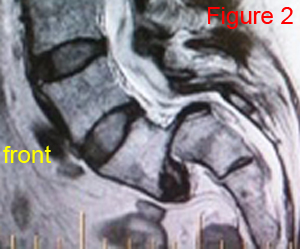ChiroGeek.com
Spondylolisthesis: Grading the Slip
 In order to grade the severity of the slip, first identify the posterior inferior corner (figures 1, or 1.5, red dots) of the slipped vertebral body and then find the posterior superior corner (orange dot) of the vertebral body (or sacral base) below.
In order to grade the severity of the slip, first identify the posterior inferior corner (figures 1, or 1.5, red dots) of the slipped vertebral body and then find the posterior superior corner (orange dot) of the vertebral body (or sacral base) below.
Once you have found them, try to estimate how far that posterior inferior corner of the slipped vertebral body has traveled in relationship to the vertebral body (or sacral base) below, in percentage terms. Get the idea? Let's try it. In figures 1, what percentage of slip do you see?
If you said about 50%, then you are correct. (Click here to see how I graded the spondylolisthesis in figure 1) Okay, we almost have this grading system down; let's continue.
The final step in the grading process is to apply the percent slip onto a traditional four-point Roman numeral quartile scale, where the vertebral body (or sacral base) below the slip, is divided up into four equal portions (or quartiles for all you statistics students). (figure 1.5)
If the posterior inferior corner of the slipped vertebral body falls between 0% and 25%, then we have a grade I spondylolisthesis. If the corner is between 25% and 50%, then we have a grade II spondylolisthesis. If its between 50%  and 75%, then it's a grade III spondylolisthesis. And finally, if the corner is between 75% and 100%, then we have a grade IV spondylolisthesis. If the slip exceeds 100%, which can happen on rare occasions, then we have a condition called a spondylptosis which is not assigned a Roman numeral.
and 75%, then it's a grade III spondylolisthesis. And finally, if the corner is between 75% and 100%, then we have a grade IV spondylolisthesis. If the slip exceeds 100%, which can happen on rare occasions, then we have a condition called a spondylptosis which is not assigned a Roman numeral.
Let's try another. How would you rate the spondylolisthesis in figure 2? Click here for the answer.
In some circles, it is correct to name a spondylolisthesis not only by the grade, but also by the presence of any visible pars fracture. For example, the spondylolisthesis in figures 1, or 1.5 could be named a "grade II spondylolytic spondylolisthesis" or "a grade II isthmic spondylolisthesis." (*We shall learn more about the isthmic spondylolisthesis below.)